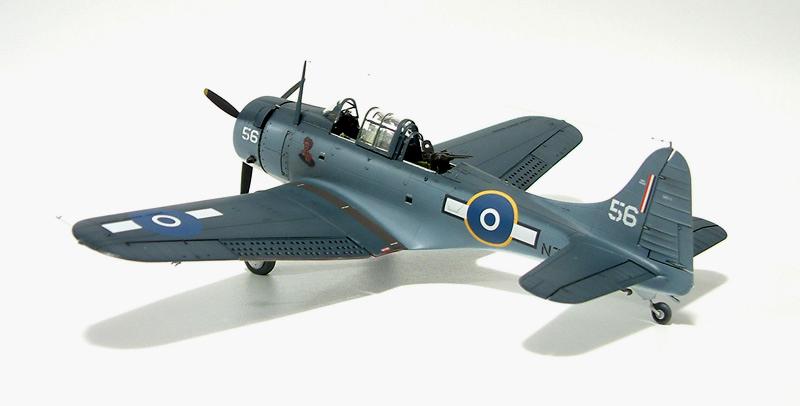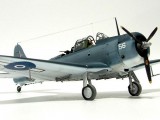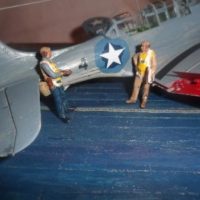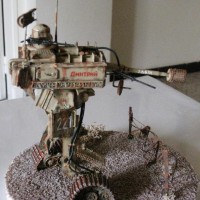DOUGLAS SBD-5 DAUNTLESS
No. 25 Squadron, Royal New Zealand Air Force
Piva Airfield, Bougainville, March - May 1944
Accurate Miniatures produce(d) some of the best models ever, I have build a few now and they are all excellent. The SBD is no exception. Construction begins with a nicely detailed cockpit which is good enough that no resin aftermarket detail set has been produced to replace. I followed the instructions for construction and only deviated from the colour call-outs where my references showed more detail.
Once I had the cockpit completed, I began the rest of the construction which went surprisingly well. I found the fit to be excellent except for a little fiddling on the underside where the wings join the fuselage and some minor clean up at the horizontal stabilizer fillets.
In the course of my research, I noticed that most, if not all, SBD-5s had their cowl flaps open on the ground. The kit parts are molded closed so I decided to try and show them opened. I cut the molded flaps out of the cowl and used the spaces created as a template to make new ones out of soda can. The operation went surprisingly well, I had the new flaps cut and installed inside twenty minutes, secured with fillets of can material so that the flap position is even variable.
The only other mod that I made was to cut off the molded tail wheel in preparation to receive a replacement larger pneumatic wheel that land-based SBDs almost always carried - certainly NZ5056 had a larger wheel. I found a suitable wheel in the spares box which I modified with a piece of hypodermic needle to represent the strut.
The kit comes with the option of either an open or closed canopy so I temporarily attached the closed canopy to the model to cover the cockpit for painting. I masked the windshield with Parafilm and then attached it to the fuselage with white glue. I masked the open canopy pieces with a combination of thin (0.125") strips of Tamiya masking tape and MicroMask. I mounted these on toothpicks with blue-tack and set them aside for painting.
I did a final seam check and re-scribed some lost detail on the underside in preparation for the paint. I drilled out the position lights on the underside of the fuselage in preparation for a different treatment which I hoped would look better than simply painting the molded detail. I filed of the raised detail representing the wingtip and turtle deck navigation lights as I wanted to try something different with these too.
I used Tamiya acrylics throughout which necessitated mixing. First, I sprayed the white underside. When that was dry, the real fun began. I made up a batch of Intermediate Blue thinned to a slightly higher thinner ratio than I have used in the past. I thinned with Tamiya thinner and used an Aztec 470 with the black tip to apply it. I made myself work sloooowwly, working with the regulator set at about 15psi and free-handed it.
Next, I mixed up the Dark Blue for the upper surfaces, again well thinned and applied the dark blue. I had to go back and forth a couple of times, including mixing up new batches of the colours. I wasn't worried about getting slightly different shades as I thought that would look realistic in any event. As it turned out, I couldn't see any difference in shade between different mixes.
With the paint applied and well cured, I used Pollyscale clear gloss in preparation for the decals. I thinned with Rubbing Alcohol and shot four or five light coats, the last being a little heavier to get a smooth clear finish for the decals.
It wasn't until I was already painting that I decided to do a RNZAF SBD-5. I thought I had some left over RNZAF roundels in my spares box but they weren't there. So, I put out a request for roundels (I could make all the other decals I needed) and was answered by Tom Hensley of North Carolina who sent me all of the SBD decals on his Aeromaster RNZAF decal sheet. Thanks Tom! The Aeromaster sheet did not include the markings for the aircraft I wanted to do, NZ5056 "Paddy's Mistake". Making the decals for the squadron and serial number was simply a matter of cutting parts of the other decals to make the required numbers. I did have trouble getting the fuselage roundels to conform properly, but that just took patience and several applications and eventually they melted down very well.
The nose art was a challenge, I ended up using a picture of my wife, which I merged with a piece of pin up art I found on the web (irritatingly, I cannot find where I got it now) and processed it heavily with Photoshop make it look like a painting. When I was happy with it, I printed on clear decal sheet. My nose art has darker hair whereas the original was a blond. This was simply a compromise because I couldn't find the right nose art image. It's close and it has my wife on it so she's happy. Unfortunately, by the time I had reduced the picture to the right size, any real resemblance to my wife was gone - it just looks like the original image now. I didn't put on the "Paddy's Mistake" because I couldn't find an image of it (to get the font) and I cannot print white in any event. We'll just say the model is depicted at that moment in time when the art was finished but the name was not yet painted on!
With the decals on and dry, I sealed them with a coat of clear gloss and again set the model down to cure. I made up wash of Windsor and Newton oil paint and naphtha and applied the wash to the control surfaces and some access panels around the engine and on the wings only.
Next, I loaded up the airbrush with very heavily thinned light grey and "reverse post-shaded" (is that a phrase I just invented?) the upper panels (including over the decals) and also accented some areas of wear and dirt on the underside. The goal was to break up the uniformity of the finish by fading the hue in certain areas without making the model look like a mosaic of different coloured panels. I applied a heavier lightening to the upper surfaces of the control surfaces though, I wanted them to look more faded than the metal panels.
Once the "reverse post-shading" was complete, I sealed it with a flat finish which I tried to leave with just a hint of sheen. I applied the flat to the upper surfaces more than the sides and underneath to simulate a greater fading due to sunlight.
I used pastels very sparingly on this one having done most of the weathering with the airbrush, only using pastels for the dust on the wheels.
For the final assembly, I worked from the bottom up, attaching the undercarriage, Yagi Antennas and tail wheel before turning the model over. While I was working on the lower side, I painted the drilled out formation lights with silver first, then with Tamiya clear colours and finally filled the recess with MicroClear. I did much the same thing for the navigation lights and was pleased with the result.
I glued the engine on, then the cowling; and added the antenna post. All of these parts were painted and weathered at the same time as the air-frame, by the way. The last job is the aerial wire, which I used stretched sprue for, attaching each end with CA glue and snapping it tight with a smoking bamboo kebob stick.



















Here's another of my builds from a couple of years ago. I hope no one minds these making a reappearance - they appeared only on my making-history.ca website which was active 2004/2005.
An excellent rendition, Mark...and beautifully photographed I might add. Accurate Miniatures were indeed "accurate"...wish they'd made more. You did an outstanding job on this one. Well done, sir.
This is one of the best finishes I have seen on anything. I love it.
Mark,
Let me add to the adjectives column...along with excellent and best, how about exceptional as in build. The build article was of interest and was comprehensive. Using your significant other as a model for a model was/is different. Reminds me of Richard Bongs a/c.
Two thumbs up on this one.
Wicked good finish and build, nice narrative.
I will join in with the others. The cockpit looks great and the finish looks great. Enjoyed the photos very much.
Very nice work, Mark. Good to see you come aboard.
Thanks Tom, good to see some familiar faces still around after I've been otherwise occupied from modeling the best part of 3 years.
Welcome Mark, I really like this, very clean, very neat just perfect really .
N.
Fabulous!
It's great
Thanks for all the comments guys, I appreciate the feedback!
Another superb model, Mark, and I enjoyed reading about the build almost as much as I did looking at the photographs.
that is really first class mark